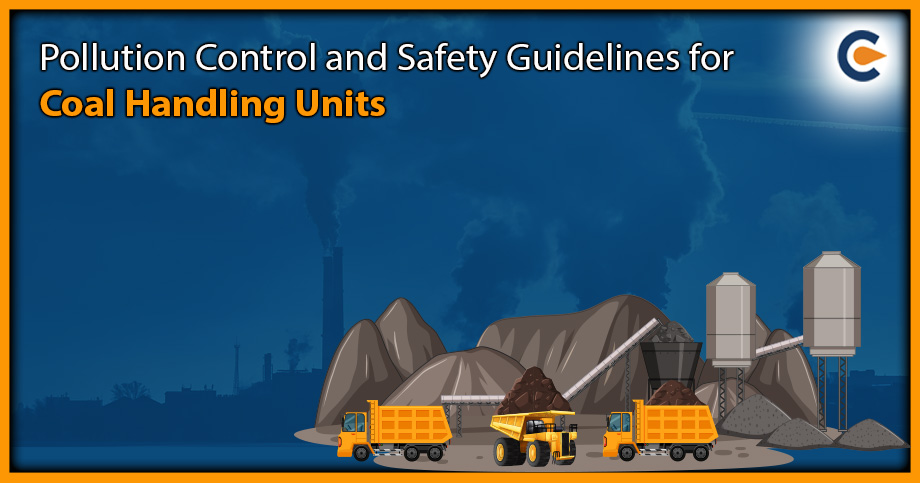A coal-based thermal power plant consists of many integrated plants/systems and equipment with electrical, mechanical, instrumentation & control and civil components. The structure of the entire plant system can be broadly classified into a main power generating plant comprising of steam generator, steam turbine and generator along with their associated auxiliaries and a Balance of Plants (BOP) system, which includes equipment other than those in the main plant system. These auxiliary plants are meant to handle coal and the waste generated through processing. The major components of the BOP system include a coal handling plant, ash handling plant, fuel oil handling & unloading system, water treatment system, circulating water system and fire protection, and detection/alarm system. In this write-up, we will understand the Pollution Control and Safety Guidelines for Coal handling units and the legalities associated with the units handling Coal and Coal waste.
To understand the brief process description of the coal handling plant system is required. So a coal handling plant consists of
- Coal unloading system: i.e. Track hopper unloading system, Wagon tippler unloading system
- Coal Crushing
- Coal Stacking & Reclaiming at Stockyard
- Dust Control System and Ventilation system
- Miscellaneous facilities: sump pumps, d cooling water system etc.
These stages have a high pollution generation potential, so the CPCB[1] developed the standard operating procedure for coal-handling plants and entities. So, as part of the SoP and Guidelines for Coal handling units, the facility has to ensure that the coal waste being handled and intended for utilization belongs to the same generation source as specified in SoP. Also, the end-use/ product produced from the waste must be the same as set in SoP. Authorization for new units that want to use the residue will be granted only after verification of details and minimum requisite facilities as given in SoP.
Standard Operating Procedure for Coal Handling Units
The following are the Guidelines for Coal handling units as per the notification released by CPCB.
Location Criteria and Guidelines for Coal handling units
- The coal handling unit/Agency will not use any agricultural land and must be located at a distance of 250 meters or more from any agricultural land.
- A government wasteland that is unsuitable for any agricultural purpose meeting the requisite siting/distance criteria must be preferred for establishing coal handling units.
- The coal handling unit/Agency must be a minimum of 500 meters away from the residential area, schools/colleges, Historical Monuments, Religious Places, Ecologically sensitive areas, and forests.
- The coal handling unit/Agency must be at least 500 meters away from the Railway line, Expressways, National Highways, State ways and District Roads and from water bodies like rivers, nalah, canals, ponds etc.
- In the case of coal handling activities at the ports, the distance and land use criteria may be relaxed and balanced by advanced pollution control equipments through mechanization accompanied by thick plantation in the surrounding. However, all such ports where coal handling is done must provide closed conveyor belts and automation for the handling of coal.
(B) Storage / handling criteria and Guidelines for Coal handling units
- The coal handling unit/Agency must store coal in such a way that the coal heap should not be more than 5 meter and a clear distance between two adjoining heaps at ground length must be atleast 5 meters so that an approach path is available in case of fire.
- There should be a mechanized loading and unloading system from the loading and unloading area to the stacking yards and into the vehicles.
- The coal handling unit/Agency must take all corrective steps to tackle air pollution at the permitted coal storage and handling site.
(C) Transportation Guidelines for Coal handling units
- The coal handling unit/Agency shall ensure that all trucks, before leaving the storage yard, must be showered with water with an adequate system, must be covered with tarpaulin or any other effective measure/device entirely and also that trucks are not overloaded as well as there is no spillage during transportation.
- The vehicle transporting coal must not be overloaded by raising the height of the carriage. Weigh scale should be located within the loading area and the port or coal park authority must ensure that no overloading is done.
- The top of the vehicle must be covered with a fixed cover instead of a tarpaulin to avoid dusting or spillage of coal.
- The coal handling unit/Agency must obtain transport permission from the local authorities under the relevant provisions.
(D) Pollution prevention Guidelines for Coal handling units
- The coal handling unit and Agency shall provide a paved approach with adequate traffic-carrying capacity.
- Units must construct compound walls all along the periphery of the premises with a minimum of 9 meters in height.
- Continuous water sprinkling must regularly be carried out on the top of the heap to prevent dusting, fire & smoke. To prevent fugitive emissions during loading/unloading, a fixed pipe network with adequate water storage and a pump must be installed. Water sprinkling shall be carried out at every stage of handling to avoid generating coal dust or other dust within the premises.
- The coal handling unit must ensure regular sweeping of coal dust from the road and ensure that there is adequate space for the free movement of other vehicles.
Air Pollution Control Measures and Guidelines for Coal Handling Units
The following adequate Air Pollution Control Measures must be installed and operated efficiently.
- Dust containment and suppression system must be available for the coal stack, loading/unloading.
- Construction of an effective wind-breaking wall to prevent the suspension of particles from the heaps.
- System for regular wetting and cleaning of the floor area.
- Entire coal storage areas/ godowns must be covered with all-weather shed roofing and side walls, i.e., in a closed shed, in case of crushing/grading/sieving activity is carried out along with adequate additional APCM must be installed.
Safety Requirement
As per the Guidelines for Coal handling units, the entity must provide adequate fire-fighting measures to avoid any fire or related hazards, including a good water storage facility, and the premises must be exclusively used for the storage of the coal. The coal handling unit must prepare and implement an onsite emergency plan.
Legal Criteria and Guidelines for Coal Handling Units
- Necessary permission from all the relevant authorities and safeguard measures under the applicable environmental acts/ rules must be taken.
- The coal handling unit/Agency must prepare an EMP or (Environment Management Plan) and implement it in true spirit to maintain the overall environment of that area.
- The coal handling unit/Agency must not carry out the operation of loadingand unloading of coal/dust till adequate air pollution control equipment for dust control/suppression is installed and operated and the Pollution NOCt under the Air Act, 1981 has to be obtained by the coal handling unit/Agency/coal importers and coal yard owners.
- The coal handling unit shall operate continuous Ambient Air Quality Monitoring Stations as per CPCB guidelines. The results of parameters like SPM, RSPM, SO2 and NOx must be submitted monthly to the SPCB.
Apart from the guidelines in the SoP, the coal handling plant and coal washeries have to obtain environmental clearance and, subsequently, Consent to Establish (CTE) and consent to operate (CTO). A business in the coal industry needs approximately 19 major approvals and licenses. Also, these businesses are required to coordinate with state departments and environmental agencies at the state and central level as coal mining and related businesses are placed in the red category of Industries by CPCB. The licences and approvals needed by the coal business may include
- Environmental Clearance as per the EIA Notification,2006
- CTE and CTO (under the Water Act and Air Act)
- Mining lease
- Forest clearance/ Wildlife clearance
- Clearances under the applicable safety & labour laws
- Environment and R&R plan for affected families
- EHS planning for the protection of workers
Documents Needed for Clearance and Approvals
- Detailed Project Report
- Environmental Impact Assessment (EIA) Report
- Environmental Management Plan (EMP)
- NOC from Local Authorities
- Public Hearing Report
- Financial Statement
- Any other document needed by the authorities.
Conclusion
In addition to the above Guidelines for Coal handling units, the entity has to ensure three rows of plantation with tall trees all along the periphery of the premises handling coal, both inside and outside of the premises along with the road. Providing a proper drainage system in all coal storage areas so that water drained from sprinkling & runoff is collected at a standard tank and can be reused after screening through the coal slit or any other effective treatment system. Also, engineering control measures, including covered conveyer belts, mechanized loading and unloading, provision of silos etc., must be provided in addition to the standards recommended in the environmental guidelines and SoP for curbing the pollution.
Read Our Article: An Overview On CPCB’s Pollution Control Measures And Action Plan











